Physics - Introduction to Magnetism | 12th Physics : Magnetism and Magnetic Effects of Electric Current
Chapter: 12th Physics : Magnetism and Magnetic Effects of Electric Current
Introduction to Magnetism
INTRODUCTION TO MAGNETISM
Magnets! no doubt, its behaviour will attract everyone (see Figure 3.1). The world enjoys its benefits, to lead a modern luxurious life. The study of magnets fascinated scientists around our globe for many centuries and even now, door for research on magnets is still open.
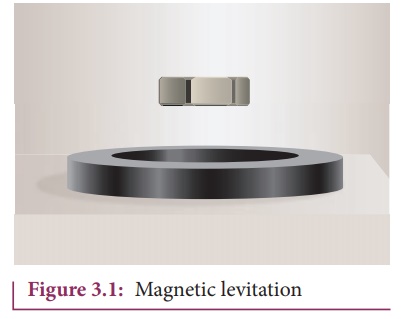
Magnetism is everywhere
from tiny particles like electrons to the entire universe. Historically the
word ŌĆśmagnetismŌĆÖ was derived from iron ore magnetite (Fe3 O4).
In olden days, magnets were used as magnetic compass for navigation, magnetic
therapy for treatment and also used in magic shows.
In modern days, most of
the things we use in our daily life contain magnets (Figure 3.2). Motors, cycle
dynamo, loudspeakers, magnetic tapes used in audio and video recording, mobile
phones, head phones, CD, pen-drive, hard disc of laptop, refrigerator door,
generator are a few examples.
Earlier, both
electricity and magnetism were thought to be two independent branches in
physics. In 1820, H.C. Oersted observed the deflection of magnetic compass
needle kept near a current carrying wire. This unified the two different
branches, electricity and magnetism as a single subject ŌĆśelectromagnetismŌĆÖ in
physics.
In this unit, basics of
magnets and their properties are given. Later, how a current carrying conductor
(here only steady current, not time-varying current is considered) behaves like
a magnet is presented.
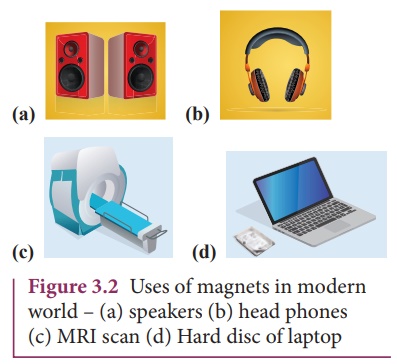
1. EarthŌĆÖs magnetic field and magnetic elements
From the activities
performed in lower classes, we have noticed that the needle in a magnetic
compass or freely suspended magnet comes to rest in a position which is
approximately along the geographical north-south direction of the Earth.
William Gilbert in 1600 proposed that Earth itself behaves like a gigantic powerful
bar magnet.
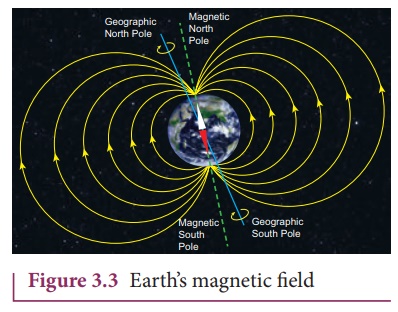
But this theory is not
successful because the temperature inside the Earth is very high and so it will
not be possible for a magnet to retain its magnetism.
Gover suggested that the
EarthŌĆÖs magnetic field is due to hot rays coming out from the Sun. These rays
will heat up the air near equatorial region. Once air becomes hotter, it rises
above and will move towards northern and southern hemispheres and get
electrified. This may be responsible to magnetize the ferromagnetic materials
near the EarthŌĆÖs surface. Till date, so many theories have been proposed. But
none of the theory completely explains the cause for the EarthŌĆÖs magnetism.
The north pole of
magnetic compass needle is attracted towards the magnetic south pole of the
Earth which is near the geographic north pole (Figure 3.3). Similarly, the
south pole of magnetic compass needle is attracted towards the geographic north
pole of the Earth which is near magnetic north-pole. The branch of physics
which deals with the EarthŌĆÖs magnetic field is called Geomagnetism or
Terrestrial magnetism.![]()
![]()
There are three
quantities required to specify the magnetic field of the Earth on its surface,
which are often called as the elements of the EarthŌĆÖs magnetic field. They are
(a) magnetic declination
(D)
(b) magnetic dip or
inclination (I)
(c) the horizontal component of the EarthŌĆÖs magnetic field (BH)
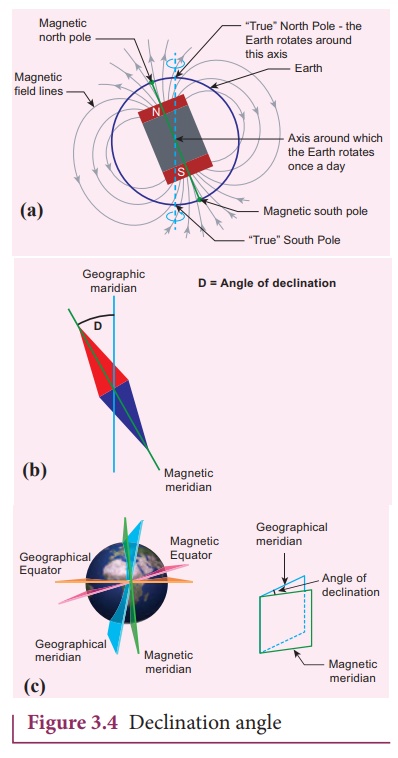
Day and night occur
because Earth spins about an axis called geographic axis. A vertical plane
passing through the geographic axis is called geographic meridian and a great
circle perpendicular to EarthŌĆÖs geographic axis is called geographic equator.
The straight line which connects
magnetic poles of Earth is known as magnetic axis. A vertical plane passing
through magnetic axis is called magnetic meridian and a great circle
perpendicular to EarthŌĆÖs magnetic axis is called magnetic equator.
When a magnetic needle
is freely suspended, the alignment of the magnet does not exactly lie along the
geographic meridian as shown in Figure 3.4. The angle between
magnetic meridian at a point and geographical meridian is called the declination
or magnetic declination (D). At higher latitudes, the
declination is greater
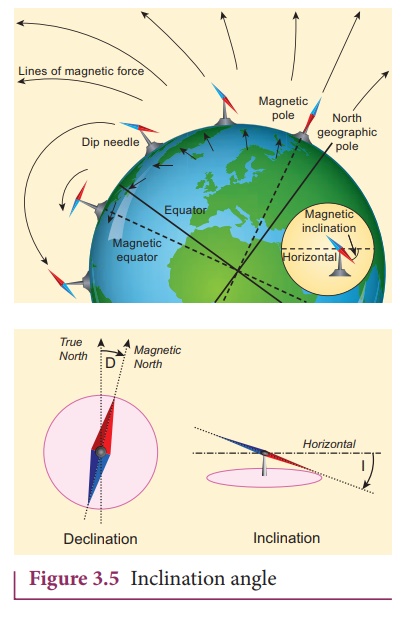
The angle subtended by
the EarthŌĆÖs total magnetic field ![]() with the horizontal
direction in the magnetic meridian is called dip or magnetic inclination (I) at
that point (Figure 3.5). For Chennai, inclination angle is 14o 16ŌĆÖ. The
component of EarthŌĆÖs magnetic field along the horizontal direction in
the magnetic meridian is called horizontal component of EarthŌĆÖs magnetic field,
denoted by BH.
with the horizontal
direction in the magnetic meridian is called dip or magnetic inclination (I) at
that point (Figure 3.5). For Chennai, inclination angle is 14o 16ŌĆÖ. The
component of EarthŌĆÖs magnetic field along the horizontal direction in
the magnetic meridian is called horizontal component of EarthŌĆÖs magnetic field,
denoted by BH.
Let BE be the
net EarthŌĆÖs magnetic field at a point P on the surface of the Earth. BE
can be resolved into two perpendicular components.

(i) At magnetic equator
The EarthŌĆÖs magnetic
field is parallel to the surface of the Earth (i.e., horizontal) which implies
that the needle of magnetic compass rests horizontally at an angle of dip, I =
0o as shown in figure 3.6.
BH = BE
BV = 0
This implies that the
horizontal component is maximum at equator and vertical component is zero at
equator.
(ii) At magnetic poles
The EarthŌĆÖs magnetic field is perpendicular to the surface of the Earth (i.e., vertical) which implies that the needle of magnetic compass rests vertically at an angle of dip, I = 90┬║ as shown in Figure 3.7. Hence,
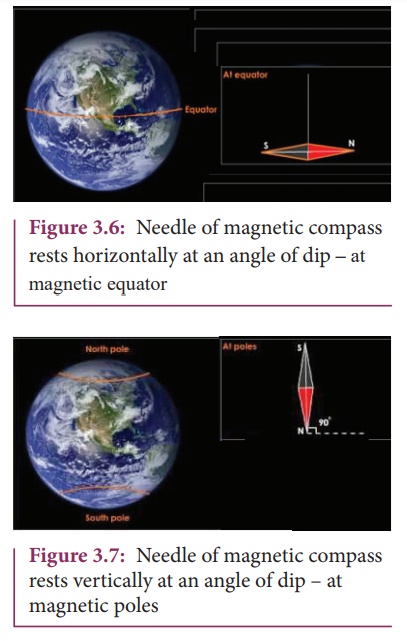
BH = 0
BV = BE
This implies that the
vertical component is maximum at poles and horizontal component is zero at
poles.
EXAMPLE 3.1
The
horizontal component and vertical components of EarthŌĆÖs magnetic field at a
place are 0.15 G and 0.26 G respectively. Calculate the angle of
dip and resultant magnetic field.
Solution:
BH
= 0.15 G and BV = 0.26 G
tan I = 00.26/0.15 ŌćÆ
I = tan ŌłÆ1(1. 732) =60┬║
The
resultant magnetic field of the Earth is

2. Basic properties of magnets
Some basic terminologies and properties used in
describing bar magnet.
(a) Magnetic dipole moment
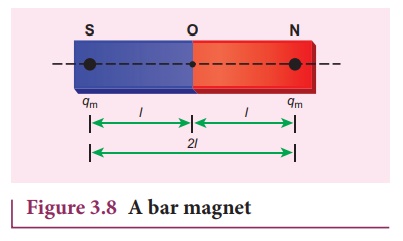
Consider a bar magnet as
shown in Figure 3.8. Let qm be the pole strength (it is also called
as magnetic charge) of the magnetic pole and let l be the distance
between the geometrical center of bar magnet O and one end of the pole. The
magnetic dipole moment is defined as the product of its pole strength
and magnetic length. It is a vector quantity, denoted by ![]() m.
m.

where ![]() is the vector drawn from south pole to north pole and its magnitude |
is the vector drawn from south pole to north pole and its magnitude |![]() |2l .
|2l .
The magnitude of magnetic dipole moment is pm = 2qm l
The SI unit of magnetic moment is A m2. Note that the direction of magnetic moment is from South pole to North pole.
(b) Magnetic field
Magnetic field is the
region or space around every magnet within which its influence can be felt by
keeping another magnet in that region. The magnetic field ![]() at a point is defined as a force experienced by the bar magnet of unit pole
strength.
at a point is defined as a force experienced by the bar magnet of unit pole
strength.

Its unit is N A-1
m-1.
(c) Types of magnets
Magnets are classified
into natural magnets and artificial magnets. For example, iron, cobalt, nickel,
etc. are natural magnets. Strengths of natural magnets are very weak and the
shapes of the magnet are irregular. Artificial magnets are made by us in order
to have desired shape and strength. If the magnet is in the form of rectangular
shape or cylindrical shape, then it is known as bar magnet.
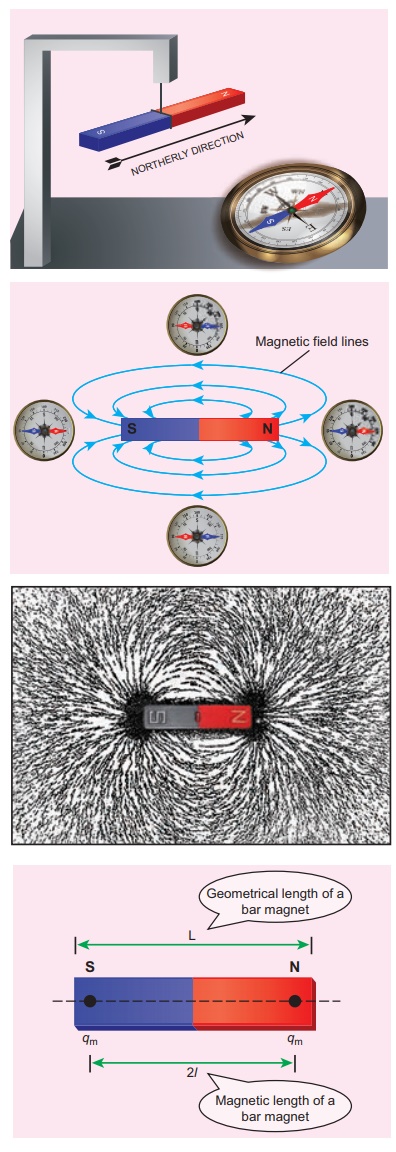
Properties of magnet
The following are the
properties of bar magnet (Figure 3.9)
1. A freely suspended bar magnet will always
point along the north-south direction.
2. A magnet attracts
another magnet or magnetic substances towards itself. The attractive force is
maximum near the end of the bar magnet. When a bar magnet is dipped into iron
filling, they cling to the ends of the magnet.
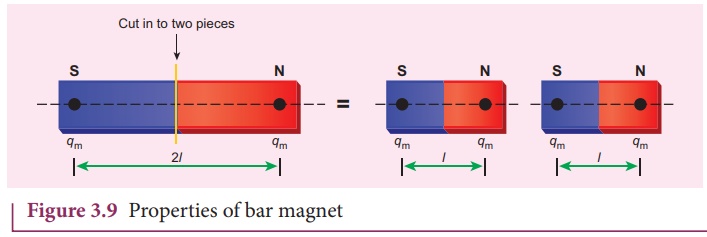
3. When a magnet is broken into pieces, each
piece behaves like a magnet with poles at its ends.
4. Two poles of a magnet have pole strength
equal to one another.
5. The
length of the bar magnet is called geometrical length and the length between
two magnetic poles in a bar magnet is called magnetic length. Magnetic length
is always slightly smaller than geometrical length. The ratio of magnetic
length and geometrical length is 5/6 .
Magnetic length / Geometricallength = 5/6 = 0.833
EXAMPLE 3.2
Let the
magnetic moment of a bar magnet be ![]() m whose magnetic length is d = 2l
and pole strength is qm.
Compute the magnetic moment of the bar magnet when it is cut into two pieces
m whose magnetic length is d = 2l
and pole strength is qm.
Compute the magnetic moment of the bar magnet when it is cut into two pieces
(a) along
its length
(b) perpendicular
to its length.
Solution
(a) a bar
magnet cut into two pieces along its length:
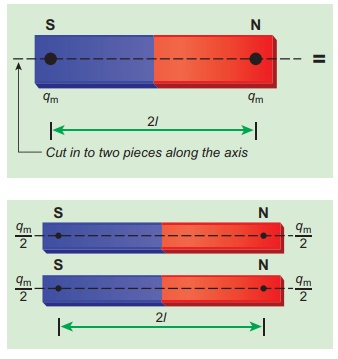
When the
bar magnet is cut along the axis into two pieces, new magnetic pole strength is
qŌĆ▓m
= qm/2 but magnetic length does
not change. So, the magnetic moment is
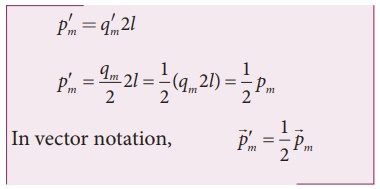
In vector
notation,
(b) a bar
magnet cut into two pieces perpendicular to the axis:
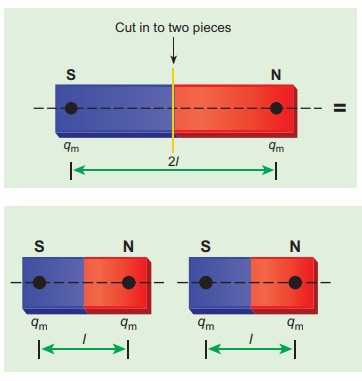
When the
bar magnet is cut perpendicular to the axis into two pieces, magnetic pole
strength will not change but magnetic length will be halved. So the magnetic
moment is
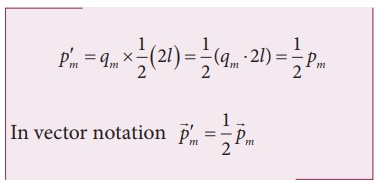
EXAMPLE 3.3
Compute
the magnetic length of a uniform bar magnet if the geometrical length of the
magnet is 12 cm. Mark the positions of magnetic pole points.
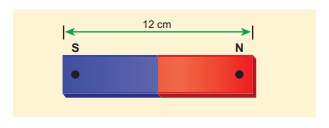
Solution
Geometrical
length of the bar magnet is 12 cm
Magnetic length = 5/6 x (geometrical length)
= 5/6 x
12 = 10cm
In this
figure, the dot implies the pole points.

Magnetic field lines
1. Magnetic field lines are continuous closed
curves. The direction of magnetic field lines is from North pole to South pole
outside the magnet (Figure 3.10) and South pole to North pole inside the
magnet.
2. The direction of magnetic field at any point
on the curve is known by drawing tangent to the magnetic line of force at that
point. In the Figure No. 3.10 (b), the tangent drawn at points P, Q and R gives
the direction of magnetic field B at that point.
3. Magnetic field lines never
intersect each other. Otherwise, the magnetic compass needle would point
towards two directions, which is not possible.
4. The degree of closeness of the
field lines determines the relative strength of the magnetic field. The
magnetic field is strong where magnetic field lines crowd and weak where magnetic
field lines thin out.
(d) Magnetic flux
The number of magnetic
field lines crossing per unit area is called magnetic flux ╬”B. Mathematically, the
magnetic flux through a surface of area A in a uniform magnetic
field is defined as

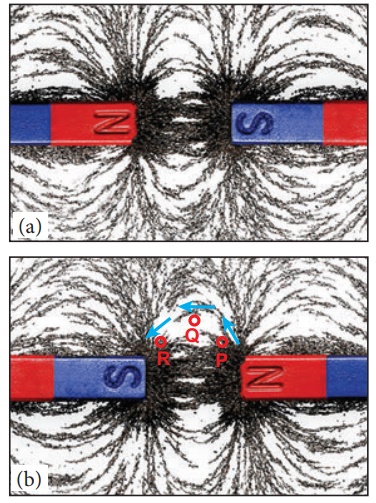
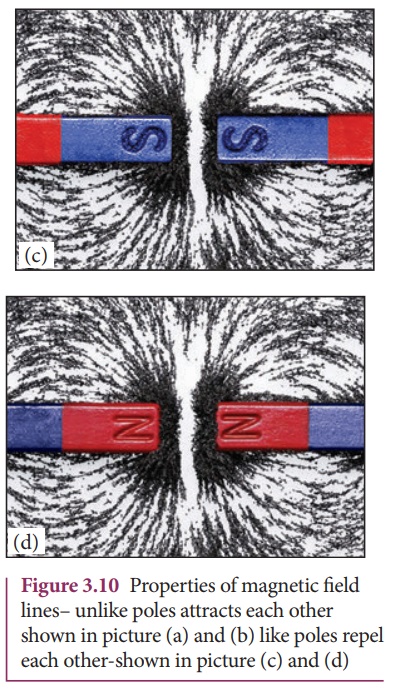
where ╬Ė is the angle
between B and A as shown in Figure 3.11.
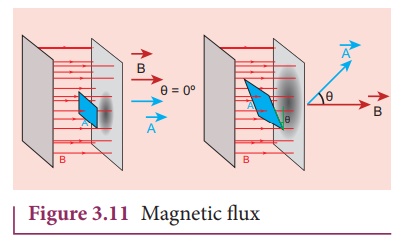
Special cases
When ![]() is normal to the
surface i.e., ╬Ė = 0┬║, the magnetic flux is ╬”B = BA (maximum).
is normal to the
surface i.e., ╬Ė = 0┬║, the magnetic flux is ╬”B = BA (maximum).
When ![]() is parallel to the
surface i.e., ╬Ė = 90┬║, the magnetic flux is ╬”B = 0.
is parallel to the
surface i.e., ╬Ė = 90┬║, the magnetic flux is ╬”B = 0.
Suppose the magnetic
field is not uniform over the surface, the equation (3.6) can be written as

Magnetic flux is a
scalar quantity. The SI unit for magnetic flux is weber, which is denoted by
symbol Wb. Dimensional formula for magnetic flux is ML2T
-2 A-1 . The CGS unit of magnetic flux is Maxwell.
1 weber = 108
maxwell
The magnetic flux density can also be defined as the number of magnetic field lines crossing unit area kept normal to the direction of line of force. Its unit is Wb m-2 or tesla.
(e) Uniform magnetic field and Non-uniform magnetic field
Uniform magnetic field
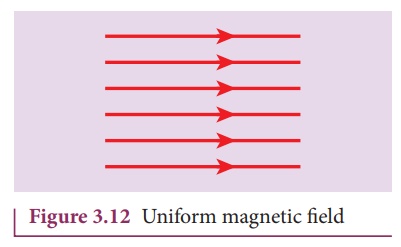
Magnetic field is said
to be uniform if it has same magnitude and direction at all the points in a
given region. Example, locally EarthŌĆÖs magnetic field is uniform.
The magnetic field of
Earth has same value over the entire area of your school!
Non-uniform magnetic
field
Magnetic field is said
to be non-uniform if the magnitude or direction or both varies at all its
points. Example: magnetic field of a bar magnet
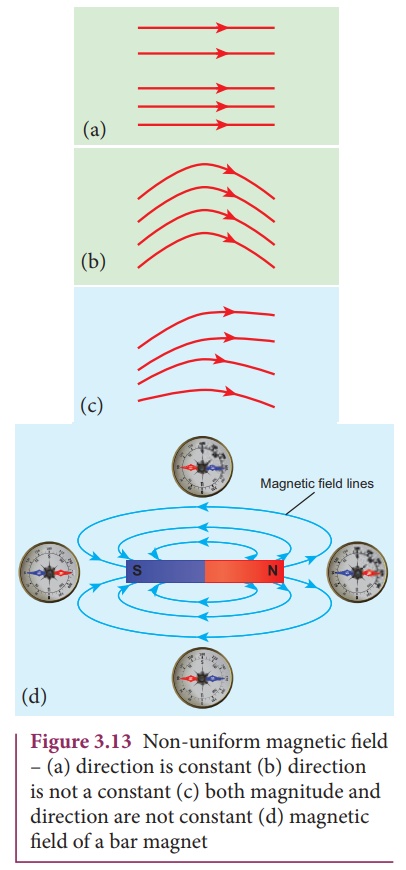
EXAMPLE 3.4
Calculate the magnetic
flux coming out from the surface containing magnetic dipole (say, a bar magnet)
as shown in figure.
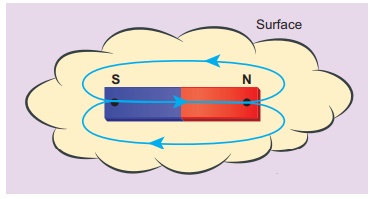
Solution
Magnetic
dipole is kept, the total flux emanating from the closed surface S is zero. So,

Here the
integral is taken over closed surface. Since no isolated magnetic pole (called
magnetic monopole) exists, this integral is always zero,

This is
similar to GaussŌĆÖs law in electrostatics. (Refer unit 1)
Related Topics